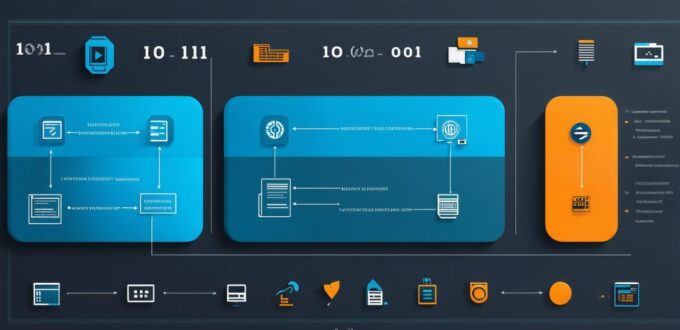Computer software refers to the set of instructions and data that allows a computer system to perform specific tasks. As a software developer, you are responsible for creating and maintaining these programs, ensuring they meet the needs of your users.
The Basics of Computer Software
At its core, computer software consists of two main components: data and instructions. Data refers to the information that the program will manipulate, while instructions refer to the set of rules that dictate how the program should behave. These instructions are written in a programming language, which is used to translate them into machine-readable code.
Some examples of basic computer software include operating systems, such as Windows and macOS, as well as office suites like Microsoft Office and Google Docs. Each of these programs has its own unique set of data and instructions that make it function as intended. Operating systems provide the foundation for all other software on a computer, while office suites allow users to create and edit documents, spreadsheets, and presentations.
More Advanced Features of Computer Software
In addition to the basic components, there are several more advanced features that can be included in computer software. Some of these features include:
- User Interface Design: The user interface (UI) is the part of the software that users interact with. This includes everything from buttons and menus to windows and icons. Good UI design is essential for creating software that is easy to use and intuitive for your users. A well-designed user interface makes it easy for users to find what they need and perform tasks quickly and efficiently.
- Security Features: Security is a major concern in the world of computer software. Programs that are vulnerable to attacks can be exploited by hackers, which can lead to data breaches or even theft of sensitive information. To mitigate these risks, software developers often include security features such as firewalls and encryption algorithms. These features help protect user data from unauthorized access and ensure that the software is not vulnerable to attacks.
- Database Integration: Databases are used to store and manage large amounts of data. Many programs rely on databases to function properly, and software developers must be able to integrate these databases into their applications. This could involve creating custom queries or interfaces for accessing and manipulating data stored in a database.
- Networking Capabilities: In today’s digital age, networking is essential for many types of computer software. Programs that need to communicate with other computers or servers must have the ability to do so over a network. This could involve implementing protocols like TCP/IP and developing secure communication methods using encryption algorithms.
- Graphics and Multimedia: Graphics and multimedia are increasingly important in modern software development. Many programs now include features like video editing, 3D modeling, and animation. These features require specialized knowledge of graphics programming languages like OpenGL or DirectX, as well as expertise in creating high-quality visual effects.
- Artificial Intelligence (AI) and Machine Learning: AI and machine learning are becoming increasingly popular in software development. These technologies allow programs to learn from data and make decisions based on that information. This could involve developing algorithms for image recognition or natural language processing, or creating chatbots that can interact with users in a more human-like way.
- Cloud Computing: Cloud computing is another important aspect of modern software development. This involves storing and processing data remotely, rather than on a local computer or server. This allows programs to be accessed from anywhere with an internet connection and makes it easier to scale up or down as needed.
- Mobile App Development: With the widespread use of smartphones and tablets, mobile app development has become an essential aspect of software development. This involves creating applications that can run on mobile devices and take advantage of unique features like GPS and camera access. Mobile app development requires knowledge of programming languages specific to mobile platforms, such as Java for Android or Swift for iOS.
- Internet of Things (IoT) Development: IoT refers to the growing network of connected devices, from smart homes to industrial sensors. This has created new opportunities for software developers to create applications that can interact with these devices and collect data from them. IoT development requires knowledge of programming languages specific to IoT platforms, such as MQTT or CoAP.
- DevOps: DevOps is a software development methodology that emphasizes collaboration between development and operations teams. This involves automating the build, testing, and deployment process for software applications, ensuring that they can be quickly and easily deployed to production environments. DevOps requires knowledge of cloud computing platforms, continuous integration/continuous deployment (CI/CD) tools, and infrastructure as code (IaC).
The Importance of Testing in Computer Software Development
Testing is a critical aspect of computer software development. It involves verifying that the software meets the requirements and specifications set by the user or client, and identifying and fixing any bugs or issues that may arise during use. There are several types of testing that can be used in software development, including:
- Unit Testing: This involves testing individual units or components of the software to ensure they function as intended. This can help identify and fix problems early on in the development process, before they become more difficult to fix.
- Integration Testing: This involves testing how different units or components of the software work together. This can help identify any compatibility issues or conflicts that may arise during use.
- System Testing: This involves testing the entire software system as a whole, including all its features and functions. This can help ensure that the software meets the requirements and specifications set by the user or client.
- Acceptance Testing: This involves testing the software with the end user or client to ensure it meets their needs and expectations. This can help identify any issues or areas for improvement that may not have been apparent during earlier stages of development.
- Regression Testing: This involves retesting the software after changes have been made, to ensure that the new functionality has been integrated correctly and does not conflict with existing code.
- Performance Testing: This involves testing the software under heavy load or usage conditions, to identify any performance bottlenecks or issues that may arise during use.
- Security Testing: This involves testing the software for vulnerabilities and weaknesses that could be exploited by hackers or other malicious actors. This can help ensure that the software is secure and protected against attacks.
- Compatibility Testing: This involves testing the software with different hardware and software configurations to ensure it works correctly in a variety of environments.
- User Acceptance Testing (UAT): This is the final stage of testing, where the software is tested by the end user or client to ensure it meets their needs and expectations. UAT can help identify any issues or areas for improvement that may have been missed during earlier stages of development.

Conclusion: What is Included in Computer Software?
In conclusion, computer software includes a wide range of components and features, from basic data and instructions to advanced AI and machine learning capabilities. Testing is a critical aspect of software development, ensuring that the software meets the requirements and specifications set by the user or client and identifying and fixing any issues that may arise during use. By understanding what is included in computer software and the importance of testing, software developers can create high-quality programs that are easy to use and effective at meeting the needs of their users.
